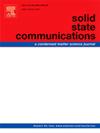研究了不同Cu溶质含量和冷却速率对Al-Cu合金组织和性能的影响
IF 2.4
4区 物理与天体物理
Q3 PHYSICS, CONDENSED MATTER
引用次数: 0
摘要
本文研究了不同Cu溶质含量(6 wt%、12 wt%、20 wt%和33 wt%)和冷却速率(6.3°C/s、11.2°C/s、20.1°C/s和92.9°C/s)对Al-Cu合金组织和性能的影响。结果表明:随着Cu含量的增加,合金的显微组织发生了变化,晶粒尺寸从697.1 μm减小到235.1 μm,二次枝晶臂间距(SDAS)从25.6 μm减小到18.5 μm,共晶成分的面积分数从12.0%增加到43.9%;在al - 20wt %Cu合金中,随着冷却速率的增加,共晶成分α-Al + Al2Cu逐渐由长条状和大量的团聚形式转变为较小的条状。α-Al的共晶相面积分数和晶格常数先减小后增大,α-Al的相对固溶度先增大后减小。本文章由计算机程序翻译,如有差异,请以英文原文为准。
The effect of different Cu solute content and cooling rate on the microstructure and properties of Al-Cu alloy
This paper studied the effects of different Cu solute contents (6 wt%, 12 wt%, 20 wt% and 33 wt%) and cooling rates (6.3 °C/s, 11.2 °C/s, 20.1 °C/s and 92.9 °C/s) on the microstructure and properties of Al-Cu alloys. The results show that the alloy's microstructure changes with the increase of Cu content, the grain size decreased from 697.1 μm to 235.1 μm, the secondary dendrite arm spacing (SDAS) decreased from 25.6 μm to 18.5 μm, and the area fraction of eutectic constituent shows an increasing trend, from 12.0 % to 43.9 %. In the Al-20 wt%Cu alloys, as the cooling rate increases, the eutectic constituent α-Al + Al2Cu gradually changes from long strips and numerous agglomerated forms to smaller strips. The eutectic phase area fraction and the lattice constant of α-Al decrease first and then increase, whereas the relative solid solubility of α-Al increases first and then decreases.
求助全文
通过发布文献求助,成功后即可免费获取论文全文。
去求助
来源期刊

Solid State Communications
物理-物理:凝聚态物理
CiteScore
3.40
自引率
4.80%
发文量
287
审稿时长
51 days
期刊介绍:
Solid State Communications is an international medium for the publication of short communications and original research articles on significant developments in condensed matter science, giving scientists immediate access to important, recently completed work. The journal publishes original experimental and theoretical research on the physical and chemical properties of solids and other condensed systems and also on their preparation. The submission of manuscripts reporting research on the basic physics of materials science and devices, as well as of state-of-the-art microstructures and nanostructures, is encouraged.
A coherent quantitative treatment emphasizing new physics is expected rather than a simple accumulation of experimental data. Consistent with these aims, the short communications should be kept concise and short, usually not longer than six printed pages. The number of figures and tables should also be kept to a minimum. Solid State Communications now also welcomes original research articles without length restrictions.
The Fast-Track section of Solid State Communications is the venue for very rapid publication of short communications on significant developments in condensed matter science. The goal is to offer the broad condensed matter community quick and immediate access to publish recently completed papers in research areas that are rapidly evolving and in which there are developments with great potential impact.
 求助内容:
求助内容: 应助结果提醒方式:
应助结果提醒方式:


